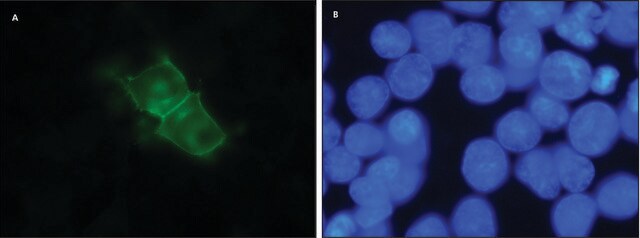MAB5300
Anti-Dopamine Antibody, clone K56A
clone K56A, Chemicon®, from mouse
About This Item
Produtos recomendados
fonte biológica
mouse
Nível de qualidade
forma do anticorpo
purified immunoglobulin
tipo de produto de anticorpo
primary antibodies
clone
K56A, monoclonal
reatividade de espécies
rat
fabricante/nome comercial
Chemicon®
técnica(s)
immunohistochemistry: suitable
Isotipo
IgG
Condições de expedição
dry ice
modificação pós-traducional do alvo
unmodified
Informações sobre genes
rat ... Slc6A3(24898)
Especificidade
The cross-reactivities were determined using an ELISA test by competition experiments with the following compounds:
Compound Cross-reactivity
Dopamine-G-BSA 1
L-DOPA-G-BSA 1/10,000
Tyrosine-G-BSA 1/36,000
Tyramine-G-BSA 1/>50,000
Noradrenaline-G-BSA 1/>50,000
Octopamine-G-BSA 1/>50,000
Adrenaline-G-BSA 1/>50,000
Dopamine 1/>50,000
Abbreviations:
(G) Glutaraldehyde
(BSA) Bovine Serum Albumin
Imunogênio
Aplicação
Optimal working dilutions must be determined by end user.
PROTOCOL for Dopamine Detection by Immunohisto/cytochemistry. Example for a rat brain.
1. SOLUTIONS TO BE PREPARED - Solution must be prepared as needed.
Solution A: 0.1M cacodylate, 10g/L sodium metabisulfite, pH 6.2.
Solution B: 0.1M cacodylate, 10g/L sodium metabisulfite, 3-5% glutaraldehyde, pH 7.5.
2. RAT PERFUSION - The rat is anaesthetized with sodium pentobarbital or Nembutal and perfused intracardially through the aorta using a pump with Solution A (30 mL): 150-300 mL/min, Solution B (500 mL): 150-300 mL/min.
3. POST FIXATION: 15 to 30 minutes in Solution B, then 4 soft washes in 0.05M Tris with 8.5 g/L sodium metabisulfite, pH 7.5 (Solution C) .
4. TISSUE SECTIONING: Vibratome or cryostat sections can be used.
5. REDUCTION STEP: Sections are reduced with Solution C containing 0.1M sodium borohydride for 10 minutes. The sections are washed 4 times in solution C without sodium borohydride.
6. APPLICATION OF DOPAMINE ANTIBODY: Use a final dilution of 1:2,500-1:10,000 in Solution C containing 0.1% Triton X100 and 2% non-specific serum. Incubate 12 sections per 2 mL diluted antibody overnight, +4°C. Then wash the sections three times for 10 minutes each in Solution C. (Note that the antibody may be usable at a higher dilution. This should be explored to minimize the possibility of high background. Additionally, note that a change in the buffering system as indicated in the protocol may change the background and antibody recognition). The specific reaction is then revealed by PAP procedure.
6. SECOND ANTIBODY: Incubate the sections with a 1:50 to 1:200 dilution of goat anti-rabbit in Solution B containing 1% non-specific serum for either 3 hrs at 20°C or 2 hr at 37°C. Then wash the sections, 3 times, for 10 minutes each with Solution B.
7. PAP: Incubate the sections with the appropriate dilution of peroxidase anti-peroxidase (for free floating method) in Solution B containing 1% non-specific serum for 1-2 hours at 37°C. Then wash sections 3 times for 10 min each in solution B.
8. VISUALIZATION: The antigen-antibody complexes are visualized using DAB-4-HCl (25 mg/100 mL) (or other chromogen) in 0.05M Tris and filtrated; 0.05% hydrogen peroxide is added. Incubate the sections for 10 minutes at room temp. Stop the reaction by transferring the sections to 5 mL 0.05M Tris. Wash tissue with solution D using 2, 10 min washes. Mount sections on chrome-alum coated slides. Dry overnight at 37°C. Rehydrate sections using conventional histological procedures. Coverslip using rapid mounting media.
For research use only; not for use as a diagnostic.
Neuroscience
Neurotransmitters & Receptors
forma física
Armazenamento e estabilidade
Informações legais
Exoneração de responsabilidade
Não está encontrando o produto certo?
Experimente o nosso Ferramenta de seleção de produtos.
Código de classe de armazenamento
12 - Non Combustible Liquids
Classe de risco de água (WGK)
WGK 2
Ponto de fulgor (°F)
Not applicable
Ponto de fulgor (°C)
Not applicable
Certificados de análise (COA)
Busque Certificados de análise (COA) digitando o Número do Lote do produto. Os números de lote e remessa podem ser encontrados no rótulo de um produto após a palavra “Lot” ou “Batch”.
Já possui este produto?
Encontre a documentação dos produtos que você adquiriu recentemente na biblioteca de documentos.
Nossa equipe de cientistas tem experiência em todas as áreas de pesquisa, incluindo Life Sciences, ciência de materiais, síntese química, cromatografia, química analítica e muitas outras.
Entre em contato com a assistência técnica